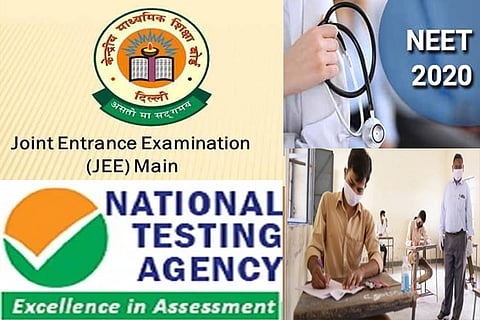

Chennai
As many as 8.58 lakh aspirants have registered for the examination, under the aegis of the National Testing Agency (NTA), which will be conducted from Sept 1-6 amid strict distancing and sanitation norms, in two batches every day, across 660 testing centres. It may be recalled that six states, ruled by opposition parties had objected to the conducting of the JEE, apart from parents and students as well.
While the notion of entering an exam hall is accompanied by anxiety, this time around both the candidates and their parents had concerns beyond the mere nature of questions in the examination. One of the pain points that the government had seemingly failed to address was that of setting up even more testing centres that could be easily accessed by students living in non-metros and small towns. This is despite the number of exam centres being raised from 570 to 660 nationally. Take, for instance, here in Tamil Nadu, due to the absence of inter-district bus services, over half the candidates could not reach the exam venue at Vellore.
Similar travails were witnessed in states like Jharkhand, where a lockdown is still in progress, and parents were compelled to shell out thousands of rupees in order to hire private vehicles to help candidates reach Ranchi, where the examination centre was located. To top it off, hotels and guest houses had not resumed their operations owing to which candidates from far-flung districts were left without accommodation or even a night’s rest before appearing for the examination. The authorities have however said that 99 pc of students who registered for the exams got the centre that they had opted for. For the lucky few in Odisha, Uttarakhand and Chattisgarh, transport was arranged to ferry candidates from their homes to the exam centres.
Another point of contention is that 15.97 lakh candidates have registered for the National Eligibility Cum Entrance Test (NEET) which will be held on September 13. Here in Tamil Nadu, the State Health Minister C Vijayabaskar had already protested against the conducting of the NEET through a letter directed at the Centre, which said it was not advisable to conduct NEET at present. For the record, the state is reporting an average of 5,900 cases per day. Anticipating the high quantum of students to appear for the NEET, the number of examination centres nationally have been raised from 2,546 to 3,843 centres.
Arguably, the student and teacher community that thrives in educational institutions was technically the last bastion for India to address, in terms of unlocking, considering the vulnerability factor of students. Having sheltered them from the risk of COVID-19 for so long by confining them to the four walls of a house or community, could only go so far. The further postponement of the examination would have resulted in a zero year for students who had already been reeling from the stress of the examinations, and for many, it had become almost imperative to just get it over with.
Now that the exam has been conducted, it signals an attempt by both the Centre and states at returning to a semblance of normalcy, with a degree of acceptable risk. The manner in which each exam hall was made to accommodate only 12 aspirants during any shift, as well the replacement of workstations after each shift points to the fact that as per need, India’s education protocols can be evolved to work around COVID. It goes without saying that there certainly are apprehensions concerning the formation of COVID clusters after such a massive assembly of students and their guardians, something we might only know two weeks from now. But wishfully thinking, if India can pull this academic experiment off, without collateral damage, it would be an example worth emulating globally.
Visit news.dtnext.in to explore our interactive epaper!
Download the DT Next app for more exciting features!
Click here for iOS
Click here for Android